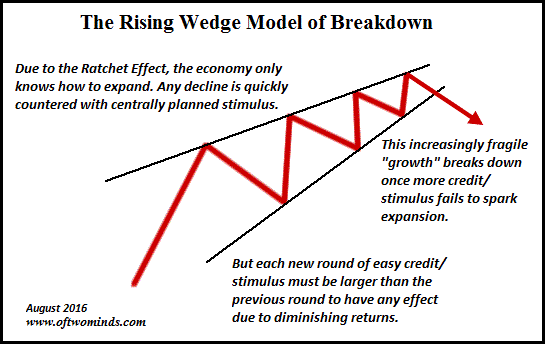This collapse of price will manifest in all sorts of markets that
are based on debt-funded purchases of desires rather than a warily
prudent priority on needs.
Since markets are supposed to
discover the price of excesses and scarcities, it's a mystery why everything
that is in oversupply is still grossly overpriced as global demand slides off a
cliff: oil,
semiconductors, Uber rides, AirBNB listings and many other risk-on / global
growth stories are still priced as if pre-Covid-19 demand was still guaranteed.
Punters are
still buying semiconductor stocks based on out-of-touch projections that are
the equivalent to counting the number of fairies on the head of a pin, ignoring
the fundamental reality that very few people actually need a new mobile
phone, vehicle, laptop, refrigerator, etc.
It boils down to confidence and
certainty. People pursue what they desire but don't need when they're
brimming with confidence in the future, bolstered by an animal-spirits euphoria
that their income and wealth will continue rising--a sense of certainty
anchored by a belief that their economic world is essentially without risk.
When confidence dissipates and
is replaced by fear and uncertainty, desireslose their luster
and needs take precedence. When you're afraid of getting a
deadly virus or losing your livelihood, status symbols and frivolous spending
no longer top the agenda.
Yet the entire risk-on / global
growth story is based entirely on desires not needs. The vast
majority of demand isn't for a pressing need, it's for euphoric aspirational
consumption, spending intended to make the buyer larger than they really
are, in their own self-image and in the image they present to the world in the
brands they display, the cafes they dine in, etc. etc.
Since the world is awash in
false assurances, magical thinking and complacency, we might ask: what's
the market value of these disconnected-from-reality fantasies? There's no
pricing mechanism for such intangibles, of course, but should counting the number of fairies
on the head of a pin give way to a new appreciation of risk and a pervasive
awareness of uncertainty, then global demand will fall off a cliff as desires are set aside
indefinitely.
In a world of bogus projections
and rigged statistics, plunging demand for oil is one of the few reality-based
measures available. One of the games being played is whenever a reality-based
measure is discovered--electricity consumption, satellite images of empty
parking lots, etc.--authorities immediately limit access to the measures and/or
unleash a tsunami of counter-narratives to discredit the real-world evidence
that global demand is cratering.
Since oil
is the master resource for the industrialized, interconnected global economy,
it's tough to argue that declining consumption of oil doesn't matter.
When demand craters, producers
must restrict supply or price will crater, too. The problem with oil
and everything else that's now in over-supply / over-production is that
producers can't survive either a sustained drop in price or a sustained drop in
production. Since both are equally fatal, producers have every incentive to
keep producing and hope that somebody else lowers their production to keep
prices high.
Alas, no producer is willing to
fall on their sword to keep prices unnaturally elevated. And so excess
production continues apace until price collapses.
This
collapse of price will manifest in all sorts of markets that are based on
debt-funded purchases of desires rather than a warily prudent priority on needs.

Audiobook
edition now available:
Will You Be Richer or Poorer?: Profit, Power, and AI in a Traumatized World ($13)
(Kindle $6.95, print $11.95) Read the first section for free (PDF).
Will You Be Richer or Poorer?: Profit, Power, and AI in a Traumatized World ($13)
(Kindle $6.95, print $11.95) Read the first section for free (PDF).
Pathfinding our Destiny: Preventing the Final Fall of Our
Democratic Republic ($6.95 (Kindle), $12 (print), $13.08 ( audiobook): Read the first section for free (PDF).
The Adventures of the Consulting Philosopher: The Disappearance
of Drake $1.29 (Kindle), $8.95 (print); read the
first chapters for free (PDF)
Money and Work Unchained $6.95 (Kindle), $15
(print) Read the first section for free (PDF).
If you found value in this content, please join me in seeking solutions by becoming a $1/month patron of my work via patreon.com.
If you found value in this content, please join me in seeking solutions by becoming a $1/month patron of my work via patreon.com.